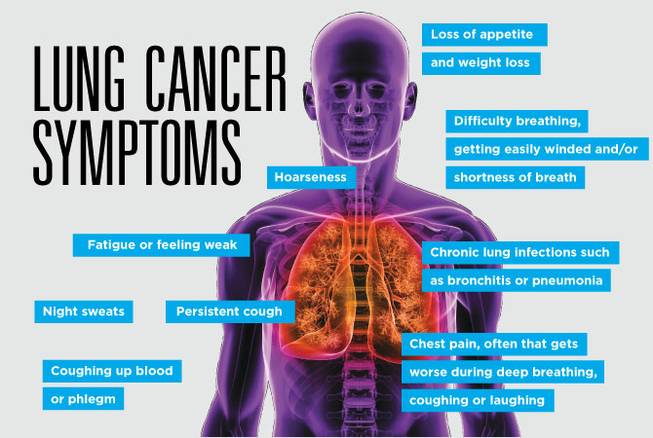
Monday, Nov. 14, 2016 | 2 a.m.
Lung cancer accounts for 1 in 4 cancer deaths in the United States and, according to the American Cancer Society, more people die of lung cancer every year than of colon, breast and prostate cancers combined. However, unlike many other cancers that occur randomly or are caused by genetic factors, lung cancer is largely preventable by abstaining from cigarette smoking.
Furthermore, with proper education and regular screenings, lung cancer is treatable when caught early. “Lung cancer is not the death sentence many people assume it is,” said James Sanchez, MD, medical oncologist at Comprehensive Cancer Centers of Nevada and MountainView Hospital. For at-risk individuals, such as smokers, lung cancer screenings can save lives.
Symptoms
Lung cancer rarely shows any symptoms in its early stages, which is part of the reason it can be so difficult to catch. “Many of the symptoms are general and nonspecific. Often, lung cancer shows no symptoms at all. Patients who aren’t proactive about getting screened for lung cancer usually go to the doctor for another reason and accidentally find the cancer during diagnostic tests,” Sanchez said.
When symptoms do present, they could be any of these:
• Loss of appetite and weight loss
• Fatigue or feeling weak
• Hoarseness
• Persistent cough
• Coughing up blood or phlegm
• Chronic lung infections such as bronchitis or pneumonia
• Chest pain, often that gets worse during deep breathing, coughing or laughing
• Difficulty breathing, getting easily winded and/or shortness of breath
• Night sweats
If the cancer has spread in later stages, there are a host of other related symptoms, including bone pain, nervous system issues, liver problems and enlarged lymph nodes.
Diagnosis
Typically, lung cancer is diagnosed once a mass has been found in the lung during a CT scan. Once a mass is identified, the oncologist or pulmonologist checks the metabolic activity of the mass; tumors, because they’re growing masses, would have metabolic activity whereas scar tissue buildup would not. From there, a biopsy would be performed and, if the mass were confirmed to be cancerous, treatment would begin.
What causes lung cancer?
“The vast majority of lung cancers are smoking-related. Smokers have a 30 percent greater chance than nonsmokers of developing the disease, and a nonsmoker who has never smoked in his or her life has a less than 1 percent chance,” Sanchez said.
Smoking causes lung cancer by putting carcinogens directly into the lungs. While everyone is exposed to some level of carcinogens throughout their lifetime from many sources, smokers tend to subject their lungs and bodies to much higher doses.
While researchers once thought the damage caused by smoking was nearly reversed once a person had quit for 15 years or more, there now is evidence to suggest that smoking causes long-term damage to DNA, even for those who have quit for many years.
While smoking is the most common cause of lung cancer, it also can occur in nonsmokers. Some patients who have chronic lung disease, such as bronchitis and emphysema, tend to have higher instances of lung cancer.
Furthermore, exposure to radon, asbestos or heavy metals can lead to lung cancer down the road. Workplace exposure to these, or other carcinogens, can be common for construction workers, miners and other similar occupations. Sanchez said it might be worthwhile for companies to provide screenings to their employees who work in high-risk environments. Some older homes also may contain carcinogens associated with lung cancer.
It’s important for smokers to seek screening
“Lung cancer is so deadly because it’s usually found late. Often, by the time the cancer is discovered, it has advanced. More awareness can change that and early screenings help a great deal,” Sanchez said.
Patients who are considered high-risk should be screened for lung cancer regularly, about once a year. A high-risk patient is often determined by age and the amount he or she has smoked. “Patients who are between 55 and 74 years old and have a history of smoking heavily should get screened,” Sanchez said.
Heavy smokers are defined by their number of “pack years,” which is the number of cigarettes they smoked per day multiplied by the number of years they’ve been smoking.
Example: Someone who smokes one pack of cigarettes a day for 10 years has a 10 pack-year history. Someone who smokes two packs of cigarettes a day for 10 years has a 20 pack-year history.
“Anyone with a 30 pack-year history or higher should get screened. Anyone within the 55 to 74 age range who has quit in less than 15 years and has a 20 pack-year history or more should also get screened,” Sanchez said.
The screening process is simple and standardized. It consists solely of a low-dose CT scan of the chest, with further testing if a mass is discovered.
Quit smoking
Quitting is the single most important thing anyone can do to help prevent lung cancer.
There are many smoking-cessation resources available for people trying to quit, including nicotine replacement therapy drugs, prescription medication, support groups, therapy and holistic approaches. While medication can help, Sanchez also recommends that patients pair smoking-cessation drugs with counseling and seek support among friends, family, co-workers and others while quitting.

Join the Discussion:
Check this out for a full explanation of our conversion to the LiveFyre commenting system and instructions on how to sign up for an account.
Full comments policy